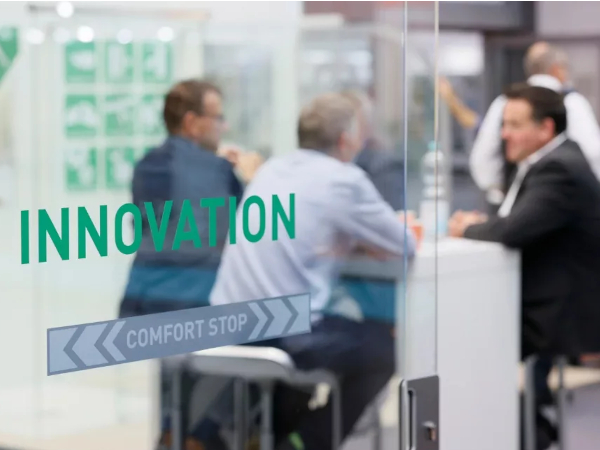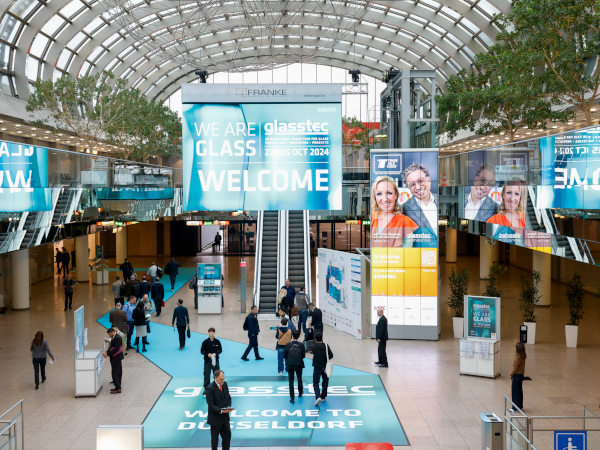Date: 8 November 2004
For edge processing, i.e. grinding and/or polishing your attention will be drawn to the internationally operating dynamic company in Fürth in any case. By their new drive units, intensive and unique cooling, as well as modular construction and user friendly handling, Rohmer + Stimpfig has been able to convince many new customers of their machines quality, capacity, life expectance and the overall service.
Of course, the development at R + S now does not stand still. So pressure-constant polishing has been extended by one special option which allows grinding and polishing of absolutely clean transitions at even very small radii, a new positioning table has been developed which does not allow any relative movement of the glass any more. Automatic trimming stations have been integrated for re-profiling of polishing wheels and sharpening of grinding wheels as well as many other points. Prepare yourself to tale potluck at the glasstec 2004.
B) Automatic in-line chip inspection of ground edges world novelty partnership with Graphikon
Usually, the quality control of ground edges of flat glass sheets is done by manual spot checks. Although this off-line inspection is very expensive and time consuming, typical edge defects like chipping or cracks cannot be really eliminated. These defects lower the optical quality and can even lead to damages in following thermal processes.
Graphikon has developed a camera based inspection system for automatic online inspection of ground edges. Thanks to its robust and flexible design, the inspection system can be integrated directly into the glass processing line. It works with nearly any glass type and geometry.
The edge is scanned completely while moving the sensor head along the edge. The continuous camera images of the edge are analyzed by an industrial PC. A special lighting guarantees a significant contrast between the original glass surface and the ground edge regardless of the light transmission rate of the glass. Focusing the sensor onto one side of the glass, the system enables to differentiate between defects on the top from defects on the lower side of the sheet. Based on the real edge contour seen by the camera, the Graphikon algorithm calculates the target contour of the sheet automatically. Therefore the system does not need any specification about the geometry of the inspected glass, it adapts automatically for nearly each contour. That means, although the algorithm does not know anything about the contour, it can handle convex or concave radiuses as well as splines or other shapes. Only quality parameters like minimum defect size or minimum amount of small defects per contour segment must be specified.
A permanent control of stitch height can also be integrated into the system. By this means the user can immediately analyze the grinding process, optimize the several process parameters and update maintenance schedules.
Any detected edge defect is immediately reported to the control system of the glass processing line for sorting out of faulty panes.
Of course, it is possible to specify different quality parameter sets for particular contour regions to fulfill special quality requirements of different customers.
Meanwhile there are more than 2 years of experience in 24/7 use of edge inspection systems. Millions of car roof glasses were 100% inspected. The customer achieved both a much higher product quality and a higher yield rate because of system-driven process improvements.
Based on the above mentioned Technology of Graphikon GmbH, Rohmer+Stimpfig, Fürth-Germany sells an automatic in-line inspection machine. It enables inline- inspection of glass sheets with an inspection speed of up to 1200 mm/s. Edge defects from 0,1mm minimum size are detected reliably. The new machine can be integrated into each glass processing line without any problems and gets a continuos automatic control of chips on every single glass produced. The glass, no matter what kind of shape, is automatically positioned on a pre-installed transport conveyor and fixed by means of special vacuum cups. Then the camera, mounted on a cnc controlled unit, is moved in X and Y around the edge. After inspection of the glass it is handed over to the ongoing transport units, enabling a trouble-free production process without any interruption. With the developing of this automatic inspection unit R + S just took over long proven and well known components of the existing cutting and grinding machine technologies such as driving units, base frame, shaped glass positioning, etc. Thus highest efficiency and highest benefit is guaranteed.
R + S furthermore produces fully automatic lines and single machines for loading, handling, cutting, breaking, drilling and milling of flat and convex glass. Further and more detailled information at www.rohmer-stimpfig.de







Add new comment